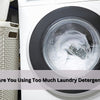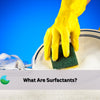How to Improve Indoor Air Quality by mopping the floor
- by Brodie Cook
Why Does Dust Keep Coming Back After You Clean?
Dust keeps coming back because it isn’t being trapped and removed properly. Dry sweeping pushes fine particles into the air instead of capturing them. Vacuuming without a HEPA filter spreads dust around, and some cleaning products leave behind residue that attracts more dust.
The key is to lock in dust instead of spreading it. Using a residue-free cleaning solution helps prevent particles from sticking to the surface. Good ventilation also makes a difference, helping to clear away any dust that does get stirred up.
Are Some Cleaners Making Your Air Quality Worse?

Some cleaning products do more harm than good. A study in Science Advances found that certain scented floor cleaners release harmful particles into the air. Citrus and pine-scented products contain terpenes, which react with ozone and create airborne pollutants similar to those found on busy city streets.
Mopping with these cleaners could expose you to billions of tiny particles per minute. These are small enough to reach deep into your lungs. Over time, breathing in these particles could impact the air we breathe and affect respiratory health. Even opening windows or using a fan may not clear them out completely. Researchers found that standard ventilation systems struggled to remove these pollutants effectively.
Switching to natural floor cleaners which are safer and non-toxic helps keep the air in your home cleaner while still getting the job done.
How to Clean Without Polluting Your Air
Trap Dust Instead of Spreading It
The best approach is to remove dust, not push it around. Using cleaning sheets that dissolve into a gentle solution helps break down bacteria and grime. Our spray mop with a microfiber pad locks in dirt, preventing it from becoming airborne.
Use the Right Cleaning Solutions
Some cleaning products do more harm than good. Harsh chemicals like bleach and ammonia release volatile organic compounds (VOCs) that lower air quality. Scented cleaners may smell fresh but often leave behind residues that attract more dust.
The Environmental Protection Agency (EPA) warns that many everyday cleaning products contribute to indoor air pollution. According to their research, eliminating harsh chemicals at the source is the best way to improve indoor air quality. Instead, they recommend using natural, plant-based cleaners that remove dirt without adding pollutants to your home.
Try our Surface Cleaning Bundle, which is a plant-based cleaner.
Improve Ventilation for Fresher Air
Proper ventilation lowers the concentration of airborne particulates, helping to keep your space fresh. Opening windows or running a fan after mopping removes any lingering particles and supports better respiratory health.
Add Plants for Extra Air Purification
Plants naturally filter the air by absorbing pollutants and releasing fresh oxygen. Adding a few greenery options to your home can help create a cleaner and more refreshing space. An air purifier would also be a great addition with some plants.
Common Cleaning Mistakes
Many people unknowingly make cleaning choices that contribute to poor air quality. Here are a few common mistakes and how to avoid them:
- ❌ Skipping sweeping or vacuuming – Dry mopping without removing loose dirt first only spreads particles around. Always start by sweeping or vacuuming with a HEPA filter to capture dust effectively.
- ❌ Using too much water – Soaking your floors can trap moisture and create a breeding ground for bacteria. A lightly damp mop is more effective for lifting dirt without causing buildup.
- ❌ Choosing harsh chemical cleaners – Bleach, ammonia, and strong artificial scents can release harmful fumes and VOCs. Opt for natural cleaners that maintain cleanliness without polluting the air.
- ❌ Reusing dirty mops or microfiber pads – If your mop isn’t clean, it spreads grime instead of removing it. Wash or replace pads regularly to avoid reintroducing dirt into your space.
- ❌ Forgetting to ventilate after cleaning – Without airflow, airborne particles stay trapped inside. Always open windows or use a fan to help remove any lingering dust and fumes.
Read more about the Do's & Don'ts of cleaning your floor

 Dishwashing
Dishwashing Laundry
Laundry Bundles
Bundles Toilet
Toilet





